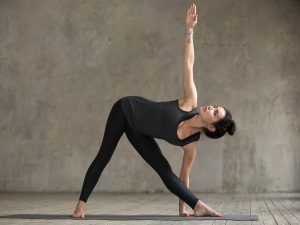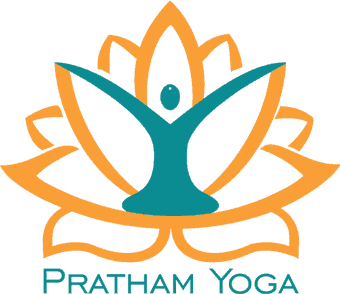Exploring the Depths of Parivrtta Trikonasana in Yoga: Unveiling the Benefits and Techniques
Yoga, an ancient practice that unites the mind, body, and soul, has gained immense popularity worldwide for its numerous health benefits. Trikonasana, or Triangle Pose, is a fundamental yoga asana that forms the cornerstone of many yoga practices. This pose, with its distinctive triangular shape, offers a myriad of physical and mental benefits, making it an essential component of yoga routines.

What is Trikonasana?
Trikonasana, derived from the Sanskrit words “tri” meaning three, “kona” meaning angle, and “asana” meaning pose, is a standing yoga posture that involves a series of stretches and twists. In this pose, the practitioner extends their legs and arms, forming a triangle shape with their body. Trikonasana is known for promoting balance, strength, and flexibility. It engages various muscle groups, including the legs, core, and shoulders, while also enhancing mental focus and concentration.
Benefits of Trikonasana:
Improves Flexibility:
Trikonasana involves a deep stretch of the spine, hips, and hamstrings, promoting flexibility in these areas. Regular practice helps reduce stiffness and enhances the overall range of motion.
Strengthens Core Muscles:
The engagement of the abdominal muscles in Trikonasana helps in toning and strengthening the core, providing stability to the body.
Stimulates Digestive Organs:
The twisting motion in this pose stimulates the abdominal organs, aiding in digestion and promoting a healthy digestive system.
Enhances Balance and Focus:
The need to maintain balance while in the triangular position helps improve concentration and mental focus. It also cultivates a sense of steadiness and poise.
Alleviates Back Pain:
Trikonasana is beneficial for individuals suffering from mild back pain as it stretches and strengthens the muscles supporting the spine.
Transition to Parivrtta Trikonasana:
Building upon the foundation of Trikonasana, Parivrtta Trikonasana, or Revolved Triangle Pose, introduces a twisting element to the traditional triangular posture. This advanced variation requires increased spinal flexibility and a deeper engagement of the core muscles.
Differences Between Trikonasana and Parivrtta Trikonasana:
While Trikonasana emphasizes a lateral stretch and engagement of the core, Parivrtta Trikonasana incorporates a twist, intensifying the stretch and involving additional muscle groups. In Parivrtta Trikonasana, the torso rotates while the legs remain grounded, enhancing the spinal twist and providing a more comprehensive stretch to the muscles along the spine and the sides of the body.
Benefits of Parivrtta Trikonasana:
Deepens Spinal Flexibility:
The twisting motion in Parivrtta Trikonasana enhances spinal flexibility, promoting a greater range of motion and improved posture.
Strengthens Abdominal Muscles:
The rotation in this pose intensifies the engagement of the abdominal muscles, leading to increased strength and toning.
Stimulates Internal Organs:
The twisting action stimulates the organs in the abdominal region, aiding digestion and detoxification.
Enhances Hip Flexibility:
Parivrtta Trikonasana involves a deep stretch of the hips, improving flexibility in the hip joints.
Muscles Involved in Parivrtta Trikonasana:
Quadratus Lumborum:
This muscle, located on both sides of the spine, is engaged during the lateral stretch and rotation in Parivrtta Trikonasana.
Obliques:
The oblique muscles, located on the sides of the abdomen, play a crucial role in the twisting motion of this pose.
Erector Spinae:
Responsible for the extension and rotation of the spine, the erector spinae muscles are actively involved in maintaining the integrity of the posture.
Incorporating Parivrtta Trikonasana into Yoga Practice:
For individuals pursuing a deeper understanding of yoga, a 200-hour or 300 hour yoga TTC in Rishikesh, such as those offered by Pratham Yoga, can provide comprehensive knowledge and hands-on experience. These courses not only delve into the intricacies of asanas like Parivrtta Trikonasana but also cover the philosophy, anatomy, and teaching methodologies essential for becoming a certified yoga instructor.
In summary, Parivrtta Trikonasana stands out as a transformative yoga pose that extends the legacy of Trikonasana. This asana, enriched with a distinctive blend of stretches and twists, takes practitioners on a profound yoga journey. Attaining mastery in advanced poses like Parivrtta Trikonasana, especially through dedicated practices like the 200 hour yoga teacher training course in Rishikesh, becomes a fulfilling pursuit. It not only nurtures physical strength and flexibility but also cultivates inner balance, aligning perfectly with the holistic approach offered by yoga training in the scenic surroundings of Rishikesh.
For those seeking a transformative yoga experience, Pratham Yoga’s teacher training courses in Rishikesh provide a holistic approach to yoga education, incorporating traditional teachings with modern insights. Through dedicated practice and guidance, aspiring yogis can unlock the profound benefits of Parivrtta Trikonasana and embark on a journey of self-discovery and well-being.


